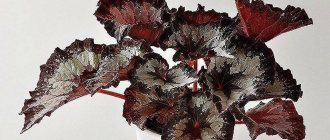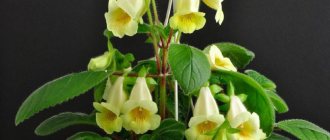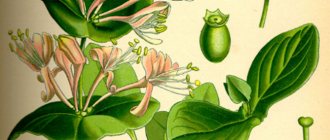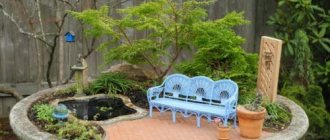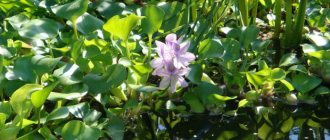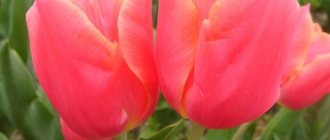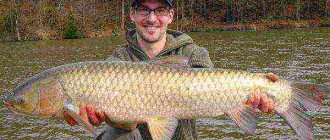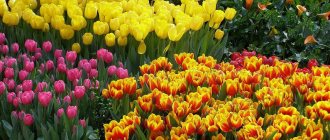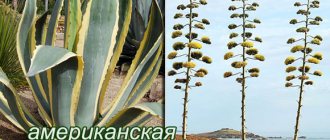Nymphea: description of the flower
Nymphaea are rightfully considered the “queens of water.” This unique, beautifully blooming flower is the subject of legends and unusual stories. The nymphea received its name in honor of the gentle semi-divine nymphs - patroness of nature and the water element. Among the Slavic peoples, the water lily is associated with fairy-tale mermaids, and according to Scandinavian legends, each water lily has its own elf friend, who is born and dies along with the flower. Nymphaeans are often mentioned in ancient Greek myths. Nymphea is sometimes called the “child of the sun”: its magnificent flowers open in all their glory with the first rays of the sun, and close at dusk.
Nymphea is a perennial herbaceous aquatic plant with a powerful, fleshy rhizome, the genus of which consists of more than 50 species. In nature there are tropical and winter-hardy plant species adapted to our climatic conditions. Nymphs grow in flowing reservoirs with slowly flowing water.
Flowering of nymphs in northern latitudes begins in June, in southern regions - in May. Beautiful delicate flowers of white, yellow, pink, lilac shades open in the morning and close, falling into the water when the sun sets. In cloudy, rainy weather, the water lily may not appear on the surface of the water. The duration of water lily flowering is up to 4 days, then the flower dies. The water lily flower is single, bisexual, and has a regular symmetrical shape. Flowers can be double or semi-double. The diameter of the flower varies from 3 cm to 30 cm. In the center there are numerous large stamens, colored yellow or orange.
Nymphs emit a bright aroma that is attractive to numerous insects that pollinate it. The main pollinators of water lilies are beetles. If the beetle does not have time to fly away from the bowl of the flower before it closes, it remains inside the water lily and goes under the water with it, and returns to the surface of the water in the morning.
The stems of water lilies are powerful rhizomes that are horizontally immersed in the bottom soil or have the form of tubers, from which numerous long roots extend that hold the flower in the soil of the reservoir.
On the surface of the water there are surface leaves and flower stalks, which captivate the eye with their splendor. The shape of the surface leaf plates is round, elliptical, with a pronounced notch. The leaves are dense, with a waxy coating, thanks to which they do not get wet. The size and color of emergent foliage may vary depending on the type of plant. Decorative leaves of water lilies can be rich green or light green, burgundy, and variegated. Elastic leaf petioles, under the influence of wind or the current of a reservoir, move freely along the surface of the water. The length of the petioles depends on the depth of the pond and the water level in it.
Leaves under water have a different structure: broadly lanceolate, membranous, rolled into a cap, under which are located flower buds and developing above-water leaves. Throughout the vegetative part of an aquatic plant there are air channels that provide it with breathing and allow it to float on water.
General information
The nymphea is native to tropical waters of Africa and South America. It can also be found in Europe. Botanists count 35 varieties of wild crops and many varieties that have been cultivated and grown in ponds.
Water lily inflorescences can be white, pink, yellow, cherry, red and peach, blue and soft purple. Flowers float on the water surface among round, large leaves.
Inflorescences and leaves grow on thick, strong stems, which are connected to the root system located in the soil of the reservoir or special containers. Nymphea can be large, dwarf and medium. Frost-resistant varieties are also available.
Planting this unusually beautiful flower in your pond is quite simple; besides, caring for the plant is minimal if the gardener creates the necessary conditions for it.
Nympheas: varieties
To decorate a decorative pond, water lilies of different sizes are used, which are selected according to the depth of their planting. Nymphs can be divided into three main groups.
Nymphea dwarf. This is a miniature water lily with a flower with a diameter of 3 to 15 cm. Planting depth is from 15 cm to 50 cm. You can buy dwarf nymphs for a pond in the store; for convenience, dwarf varieties of o. Among the popular varieties used for decorative ponds:
- Alba - white water lily.
- Rubra - dark red flowers.
- Aurora is a chameleon variety, at the beginning of flowering the flowers are creamy yellow, towards the end of flowering they acquire an orange tint.
Nymphea average . The flower is larger, up to 18 cm. Can be planted in a pond up to 60 cm deep. Medium-sized water lily varieties:
- RoseArey is a beautifully flowering water lily, up to 15 cm in diameter with soft pink petals that fade in the sun and acquire a pale, almost white hue. Thanks to this feature, the pond looks especially attractive. It grows no more than 1 meter wide.
- Helvola is a yellow-flowered nymph.
- Attraction - a flower with red petals dotted with small white spots.
Nymphea is large. Water lily flowers are large, reaching a diameter of up to 25 cm, and can be planted in a pond up to 1 meter deep. Varieties of large-flowered nymphea:
- Chromatella is a yellow water lily that prefers partial shade and is planted in ponds up to 1.5 meters deep.
- Escarboucle is a nymph with bright crimson petals, the flower closes late at night.
Varieties and types of water lilies
White water lily is a large variety. It will grow in Africa and Eurasia in quiet river backwaters. It has large dark green leaf blades and large white inflorescences with yellow anthers that have a delicate aroma.
Snow White water lily - the plant belongs to small varieties. It grows in reservoirs in the middle part of our country. The leaf blades have a dark green tint, a round shape with a part dissected at the base. The inflorescences are small, white in color with a pleasant aroma.
Yellow Water Lily - nymphea is one of the smallest and easiest varieties to grow. It has round leaf plates of a green hue with red streaks. The inflorescences are small, pale yellow with a light aroma.
Nymphea Tiger Red - the plant belongs to small varieties. The culture has large red leaf blades with black specks. The inflorescences are small, white, and have a pleasant aroma. Flowering time occurs in the first half of summer and ends in early autumn. This variety can be grown in both ponds and aquariums.
Pink water lily - the plant belongs to small varieties. The water lily has large olive green leaves with a patterned edge. The inflorescences are bright pink with a yellow center, resembling a lotus in appearance. The flowers have a persistent pleasant aroma.
Water lily Victoria Regia
Refers to large varieties. The leaf blades are large, resembling a plate with raised edges, and there are more veins on the inside of the leaf. The inflorescences are large, snow-white with a yellow anther and a pleasant aroma. Flowering time occurs in mid-summer and ends in early autumn.
Nymphea Rubra - the plant belongs to the middle varieties. The leaves are large, flat, round and green in color with a dissected edge. The inflorescences are medium-sized, red-crimson in color with a yellow center. The flowers have a pleasant aroma. The flowering time of nymphs lasts from mid-summer to early autumn.
Water lily tetrahedral - the plant belongs to small varieties of water lilies. Grows in Siberia. The leaf blades are small, round and dark green. The inflorescences are small, lilac-pink in color with a yellow center and a pleasant aroma. The water lily blooms from mid-summer.
Nymphea Mikrantha - has both above-water and underwater leaf plates. The surface leaves are large and green in color. Those that grow underwater are smaller and have a red-green hue with dark specks. The inflorescences are white, star-shaped with a pleasant aroma. Flowering time occurs in July and ends in September.
Nymphea Rudge - refers to small varieties of nymphs. The leaf blades are large, round, green-pink in color. The inflorescences are small, pleasantly smelling white with a yellow center. The water lily blooms in mid-summer.
Nymphea Stellata
The plant differs from other varieties in its large, round, reddish leaf blades. The inflorescences are large, star-shaped. They can have red, white, blue and gradient shades.
Nymphea Vanvisa - this variety of water lilies was bred in Thailand. The leaf blades are round, large, dark green with red streaks. The inflorescences are large, located high above the water. The petals have a pink tint with light stripes and a pleasant aroma. The flowering time of the water lily occurs in mid-summer and ends in autumn.
Marsh Water Lily - the plant grows in the backwaters of rivers with standing water. The leaf blades are large, dark green with a dissected edge at the petiole. The inflorescences are medium-sized, white with a yellow center and a pleasant aroma. The water lily blooms in late June - early July.
Nymphea Black Princess is a frost-resistant, unpretentious variety. The leaves of the plant are round, flat, dark green or burgundy. The inflorescences are large, velvety dark cherry in color with a yellow anther. The flowering time of the water lily occurs in July and ends in early autumn.
Nymphea Viviparous - the plant belongs to small varieties. The leaf blades are oval with a slightly pointed end. They have a light green tint with dark and burgundy specks. The plant has leaf blades both above and below the water. The inflorescences are small, white in color. This variety of nymphs can be grown both in a pond and in an aquarium.
Nymphea Attraction
The culture belongs to large varieties. The leaf blades are round, olive or burgundy in color. In young nymphs the inflorescences are pale pink, while in adult plants they are crimson with white stripes on the petals. This variety was bred in 1910.
Mexican water lily - the plant belongs to the middle varieties. The water lily grows in Texas. It has large flat leaf blades and small, oval-shaped leaves folded into a cup shape. The flowers are medium-sized, yellow in color, located above the water. The water lily blooms in mid-summer and early autumn.
Egyptian water lily - refers to small varieties of water lilies. The leaf blades are small, bright green with dark specks. They grow both above and below water. Water lily inflorescences are small, white with a yellow center.
Water lily small-flowered - in the wild the plant grows in West Africa. The leaf blades are round, small, olive in color with dark and red streaks. The inflorescences are also large, white with pointed petals. The plant blooms from mid-June to early September.
Blue water lily is an amphibious perennial from the lotus family. It has leathery, dark green leaves on the outside and burgundy on the inside. The inflorescences are medium-sized, blue or pale purple in color with a pleasant aroma. The water lily blooms during the day, in the evening the bud closes and sinks under the water.
How to plant a nymph in a pond
The success of growing nymphs in a pond depends on quality planting. To plant the plant, you will need a low, wide container with drainage holes to allow the rhizome to grow and reproduce more freely. For dwarf varieties, small buckets are suitable, for medium and large varieties - 10-12 liter buckets or other large containers. In addition, in flower shops you can purchase special baskets for planting nymphs. Next, you need to prepare the ground for planting nymphs; the composition of the soil consists of:
- 1/3 wet clay, free of sand and lumps;
- 1/3 garden soil, with the addition of peat;
- 1/3 cow dung (burnt).
All components must be mixed well and placed at the bottom of the container. To plant water lilies, it is recommended to first use humus and then a soil mixture.
When planting a plant, the rhizome should be positioned horizontally, directing the roots down, gradually covering them with earth and compacting them. The edge of the rhizome opposite the growing bud must be placed close to the wall of the bucket to allow the root to grow freely. To prevent the soil from being washed out by water, a layer of clean sand is poured on top of the earthen mixture and small stones or pebbles are placed.
Planting a water lily nymph in a pond
Containers with planted water lilies can be placed on the bottom of the reservoir at the optimal depth for them, taking into account which group they belong to. The planting depth is calculated based on the surface of the soil in the container, and not on the bottom of the pond. It is worth considering that at depth the water has a rather low temperature, since it is poorly heated by the sun, it will be much more difficult for leaves and flower buds to reach the surface of the reservoir. However, immersing the container with the water lily too shallowly is undesirable - the leaves and flowers of the nymphea grow quite quickly and will be above the water in just a few days. Nymphs begin to bloom soon after planting.
Nymphea growing from seeds
The seed propagation method is used less frequently, since it is suitable only for warm climates and is used mainly for selection. Plants propagated in this way turn out weak and small in color, and bloom only in the fourth year after planting.
To plant a nymph using seeds, seed material is sown in the ground and containers with seedlings are lowered to the bottom of the pond until germination.
Nymphea after shopping in a store
If you decide to purchase a beautiful nymph in a store where it is sold in a special container, follow these recommendations:
- After purchasing the plant, you need to plant it immediately, without waiting for it to dry out. As a rule, water lilies are sold in containers filled with water or sprinkled with perlite.
- When choosing a plant, pay attention to the number of dormant buds. Take a closer look to make sure there are no signs of rot. You should also carefully examine the rhizome. After purchasing, it is advisable to rinse the root with running water to prevent possible infections or pests from entering the pond.
Problems when growing nymphs
Gardeners who grow nymphs may have some problems.
Most often you encounter the following:
- Lack of flowering - a water lily may not bloom for two reasons. Due to improperly selected soil and low temperatures or the container being too deep in the water. After eliminating these shortcomings, the plant will definitely bloom.
- Holey leaf plates - the appearance of holes in the leaf plates is evidence of an attack by the water lily booger. To destroy this pest, the reeds that grow in the pond along with the nymph should be cut down, but in general, it is better not to plant them in the same pond with water lilies.
- Green water in a pond with water lilies - this problem is caused by duckweed blooming and is not dangerous for the water lily. However, to clear the water of algae, you can filter it or add special preparations that are harmless to the plant, which will completely clear the pond of blooming algae.
If you follow all the rules regarding water lily care, the problems described above will not arise.
Nympheas: pond care
Caring for nymphs is not difficult; it is enough to remove dead flowers and yellowed leaves. It is worth noting that water lilies grow very quickly on the surface of the pond. When the leaves cover the entire surface of the pond, the flowers become smaller and bloom less often. Therefore, when planting water lilies in a pond, it is necessary to leave at least half of the pond free and not plant a large number of plants at once.
A mandatory condition for caring for a pond is its spring cleaning, after wintering the nymphs. The container immersed in water must be removed and cleaned of organic debris and fallen leaves. The pond should also be cleared of debris and dead coastal plants.
Location of water lilies
A sunny location is best for nymphs. If the pond is in complete shade, the plant will not bloom. Lilies should be planted one per 0.5-4 square meters. m. Otherwise, there will be a feeling of neglect. It should also be noted that lilies love stagnant water, and it is not recommended to arrange fountains next to them.
Overwintering nymphs in a pond
Winter-hardy nymphs grown in our region tolerate frosty winters well, provided that their roots do not freeze into the ice - under such conditions the nymph will die.
If the pond is more than 50-60 cm deep, the nymph will overwinter well, since the pond will not freeze to the very bottom. For reliability, the pond can be insulated by laying boards, layers of foam plastic on the bottom, or covering it with a double layer of film.
If the reservoir is shallow, less than half a meter deep, you can dig a small hole at the bottom and deepen the roots of the plant into it for the winter. This method is not suitable for small reservoirs with an artificial bottom, so the container with the rhizome is moved indoors. You can store water lilies directly in a container packed in a plastic bag, leaving room for air circulation. The packaged container with the water lily is placed in a basement with a positive temperature (from 0 to 10 degrees). During the winter, you should monitor the soil; it should be moist and the plant should not dry out.
You can store nymphs in winter outside the container where they grew. To do this, you need to remove the plant from the container, cut off the stems and leaves. Place the rhizome of the water beauty in a plastic bag filled with perlite or damp moss and place it in the refrigerator for the winter, remembering to keep the root moist.
Winter storage of nymphs and whether it can be propagated by seeds
In natural reservoirs, where the water freezes more than a meter deep, water lilies sink to the unfrozen bottom and survive the winter there excellently. In garden plots there are rarely ponds deeper than one meter, so you should remove the plant from the pond and place it in containers with water for the winter, and store it in a basement or cellar. At the beginning of spring, when the ice has completely melted, containers with nymphs are placed in their usual places.
Propagation by seeds is carried out in order to select new varieties or improve the quality of existing species. The purchased seeds are planted in small pots and lowered into water to a shallow depth. Vegetation from seeds occurs over a long period and is possible under natural conditions only in southern latitudes.
Planting a nymph
A convenient and common method of propagating nymphs is simply dividing the powerful rhizome of an adult plant into several roots with one or two buds. The separated roots are placed in new containers with ordinary muddy soil and weighted down with pebbles on top.
The surface of the water with a slow flow calms and puts you in a lyrical mood. No one, we hope, will refuse to have such a relaxing corner with wonderful water lily nymphs in their possession. It’s nice after working in the garden to sit near the pond, admire the flowers and listen to the soothing murmur of water.
Pests of nymphs
Nymphs almost never get sick. A possible difficulty encountered in growing nymphs in a decorative pond is root rotting. The cause of rotting may be a fungal infection that infected the root upon purchase, as well as the appearance of toxic substances in the reservoir. Prevention of the disease is the purchase of a healthy plant and timely thinning of the nymphs.
- The main enemy of the queen of reservoirs is aphids. The difficulty in killing aphids is that the pond cannot be treated with pesticides. Aphids can only be washed off from water lily leaves mechanically.
- The pitcher leaf beetle is a small bug with a brown color. It harms water lilies by laying eggs on the leaves of the plant. The hatched larvae feed on the leaves, gnawing holes in them. Leaf beetle larvae are collected manually, and damaged leaves are removed.
- Leaf spot is a disease characterized by the appearance of black round spots on the leaf blade of water lilies. After some time, the spots increase in size, rot and through holes form in the leaves. If this disease is present, the leaves should be removed.
Beautiful, wide-open nymphea flowers surrounded by floating leaves in a pond fascinate and delight everyone around. A pond with water lilies in the garden is a decoration of the garden and the pride of any summer resident. By following all the rules for planting and wintering nymphs, you will be able to enjoy their beauty for many years.
Content
- General information
- Varieties and types of water lilies
- Nymphea planting and care in the pond
- Soil for nymphs in still water
- Transplanting nymphs
- Fertilizer for nymphs
- Nymphea bloom
- Pruning water lilies
- Wintering nymphs
- Reproduction of nymphs
- Nymphea growing from seeds
- Nymphea in the aquarium: planting and care
- Diseases and pests
- Problems when growing nymphs
- Water lilies signs and superstitions
- Conclusion
Nympheas in a pond, photo
Water lilies signs and superstitions
It is believed that the plant is a talisman against everything bad. This flower is suitable only for people with a pure heart. In ancient times, it was believed that only a good person could pick an inflorescence; a bad person, with negative thoughts and intentions, would be drowned by mermaids who protect the grass. It is for this reason that signs appeared regarding the fact that it is impossible to tear a nymph and bring it into the house.
Among the Slavs, this flower was considered a powerful amulet. Those who had to travel frequently took the plant with them as an amulet. It was also believed that the flower could awaken talents in a person and cure any disease.
From ancient times to the present day there has been a sign that a water lily cannot be given as a gift, as it will bring misfortune. In fact, it's exactly the opposite. A bouquet of nymphs given to your other half will allow you to harmonize your relationship and bring positive energy into your home.
